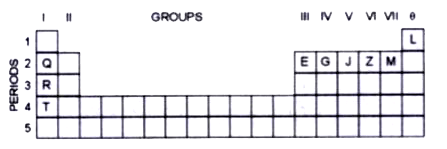Use the periodic table to answer the following questions.
(a) Identify an element with five electrons in the outer subshell.
(b) Identify an element that would tend to lose two electrons.
(c) Identify an element that would tend to gain two electrons.
(d) Identify the group having metal, non-metal, liquid as well as gas at the room temperature.
a. The general electronic configuration of the elements having five electrons in the outer subshell is .This electronic configuration is characteristic of elements of group i.e. hallogens and their examples are ,,,,,etc.
b. The elements which have a tendency to lose two electrons must have two electrons in the valence shell. Therefore, their general configuration should be . This electronic configuration is characterstic of group elements, i.e. alkaline earth metals and their examples are ,,,, etc.
c. The elements which have a tendency to accept two electrons must have four electrons in the valence shell. Therefore, their general electronic configuration is . This electronic configuration is characteristic of group elements and their examples are ,,, etc.
d. A metal which is liquid at room temperature is mercury. It is a transition metal and belongs to group . A non-metal which is a gas at room temperature is nitrogen (group 15),oxygen (group 16),flurine, chlorine (group 17) and inert gases (group 18). A non-metal which is a liquid at room temperature is bromine (group 17).
Topper's Solved these Questions
- APPENDIX - INORGANIC VOLUME 1BOOK - CENGAGE CHEMISTRY ENGLISHCHAPTER - APPENDIX - INORGANIC VOLUME 1EXERCISE - Exercise very short
70 Videos
- APPENDIX - INORGANIC VOLUME 1BOOK - CENGAGE CHEMISTRY ENGLISHCHAPTER - APPENDIX - INORGANIC VOLUME 1EXERCISE - Exercise Short
146 Videos
- ALKYNESBOOK - CENGAGE CHEMISTRY ENGLISHCHAPTER - ALKYNESEXERCISE - Exercises (Archives - Analytical and Desriptive Type)
4 Videos
- ATOMIC STRUCTUREBOOK - CENGAGE CHEMISTRY ENGLISHCHAPTER - ATOMIC STRUCTUREEXERCISE - Concept Applicationexercise(4.3)
19 Videos
Similar Questions
Use the periodic table to answer the following questions :
Identify an element with five electrons in the outer subshell.
View SolutionUse of Modern periodic table to answer the following questions:
(i) Identify an element with six electrons in the outermost shell.
(ii) Identify an element that would tend to lose one electron.
(ii) Identify an element that would tend to gain three electrons.
(iv) Identify the group having metal, non-metal, liquid as well as gas at 30∘C temperature.
View SolutionUse the periodic table to answer the following questions :
Identify an element that would tend to gain two electrons.
View SolutionUse the periodic table to answer the following questions :
Identify an element that would tend to lose two electrons.
View SolutionUse the periodic table to answer the following questions :
Identify the groups having metal, non-metal, liquid as well as gas at the room temperature.
View SolutionElement X has two electrons in its M shell. Identify the element.
View SolutionIn period 2, element 'A' is to the right of element 'B'.
If an element 'C' had a low electronegativity and ionisation potential it would have more tendency to _______ [gain/lose] electrons.
View SolutionIdentify the common name of group of elements based on following facts: Elements with 2 electrons in the valence shell
View SolutionUse the letters only written in the Periodic Table given below to answer the questions that follow :

Which element has its electrons arranged in four shells ?
View SolutionA part of the periodic table is shown below with one element missing:

Based on the above table, answer the following question:
Identify the missing element.
View Solution
